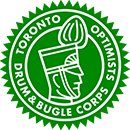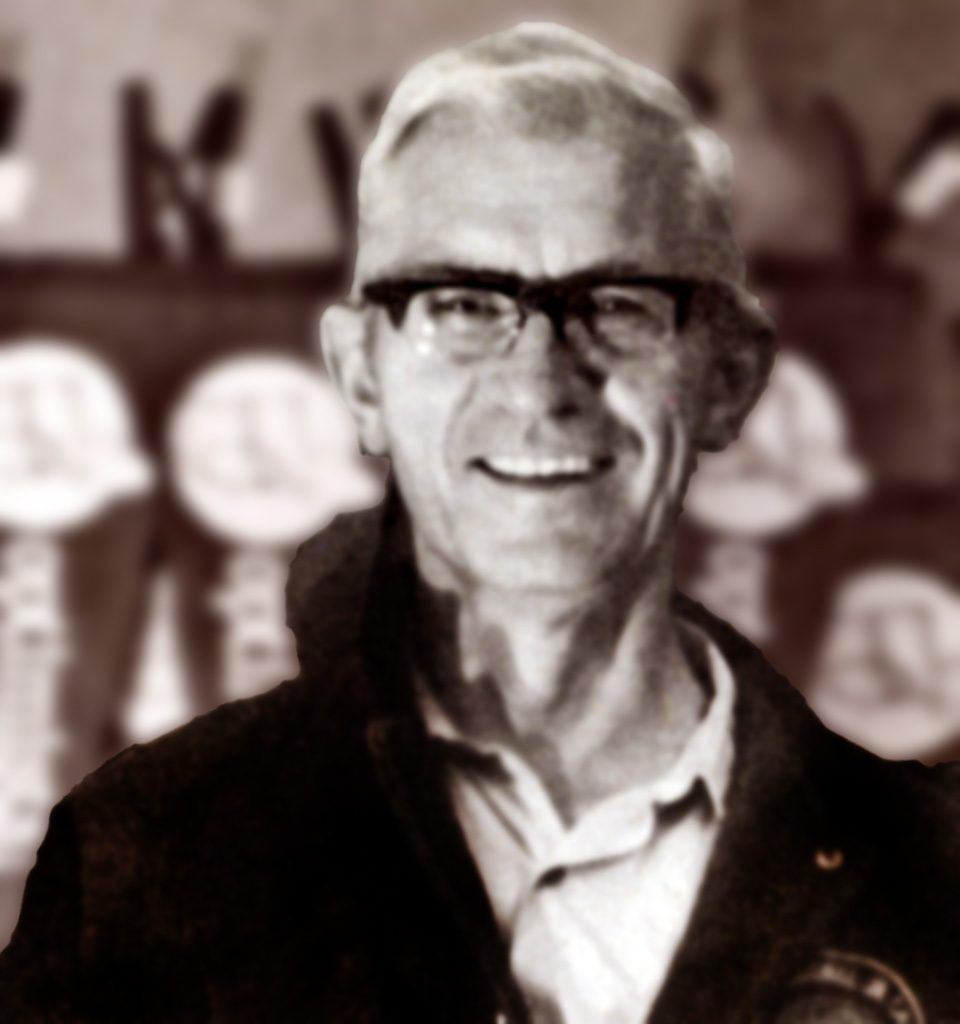
March On! ...the history of the
Toronto Optimists Drum & Bugle Corps
Toronto, Ontario, Canada
Tribute To a Humble Genius
Submitted by: Brian Hogan
Brian remembers a wonderful mechanical genius and great supporter of The Optimists.

When I joined the Toronto Optimists in 1969, there were two brothers in the corps: Kerry and Dana Burrage. Kerry was a second year soprano player with the corps and Dana was a rookie tenor drummer. This story, despite the fact that they’re two good guys, is not about them, but rather about their father, Ben.
At that time, the corps, like most others, was running on a shoestring budget and getting the corps from home to contest and back home was the priority. Equipment purchases were sometimes few and far between. All this to say that we made due with what we had. In 1968, our drum instructor, Ron Kaiser (who was an innovative guy all on his own) decided to take a couple of bass drums, flip them on their sides, remove the bottom heads, secure them together and sling them over some unsuspecting drummer to lug around for about 11 minutes at a stretch. He made two sets of these, tuned to match up with the music and the horn line. You see, tympanis were mighty expense and it was a lot easier to scrounge up a few extra bass drums. If two are good, then four must be better. That’s how many we marched in 1969. It was really quite interesting. Here were four guys, carrying eight bass drums, all tuned to different pitches. We played Dave Brubeck’s “Blue Rondo al a Turk” as a drum solo that year, all done on these “double basses”. I would suspect that the four guys who lugged these things around no doubt are still feeling the effects today.
If four “doubles” are better, then four “triples” must be best, right? In 1970, we managed to strap four sets of three bass drums together. They looked like the biggest set of triple tenors you’ve ever seen and you can imagine how much these things must have weighed. At that time, tympani players were allowed to ground their drums, so we figured that we should be able to ground these cumbersome things and not be penalized. I don’t really know how the rule regarding grounding read at the time. Now, how to do this. This is where Ben Burrage comes in. The sets had to be playable while grounded, i.e.., standing up high enough to play and easily donned and doffed. I suspect that permanent or detachable legs were options that were explored, but Ben had a better idea. What about retractable legs? So away he went into his garage or basement and when he emerged, he had the prototype for a set of legs that would quite easily swing up, out of the way under the set, while the set was being carried. These legs were things of beauty. In the space between the three drums, at the player’s chest, was a lever, which operated a system of wires and pulleys, which were attached to the three legs. The legs were located on the outsides of the two side drums and the third was located in the middle, at the outside of the middle drum. By simply grasping the lever and rotating it 180 degrees, the legs would rotate up out of the way and when the player wanted to stand them up, he would do the opposite and slip the harness lugs from the drum set, leaving the set free-standing. The drummers were of course, ecstatic. During concert and parts of some drum solos, they could stand the sets up and not have to bear all of the weight all of the time. At this time, harnesses were in their infancy. Most drum lines still slung all of their drums: snares, tenors and in many cases tympanis. So, Ben came up with a practical harness for the “triple” basses, which looks quite similar to what is currently in use. Whenever we went anywhere, these contraptions were the subject of much ogling, ooooohing and aaaaaaaahing.
In the early ‘70s, a strange phenomenon was occurring. National flagpoles started to get higher and higher and those carrying them started to hold them out of their slings, the higher the better. I remember the Kilties’ national flag bearer holding his flagpole in one hand, high up over his head. We were no exception. In some cases, size does matter. How do we get higher, longer, bigger? (Sounds kind of Olympian, doesn’t it?) Ben? It’s quite simple, really. You start with a piece of square extrusion about eight feet long and a piece of shiny pipe about seven feet long. The pipe must fit into the extrusion. Now it’s simply a matter of attaching yet another series of wires and pulleys to the two main pieces so that, when the carrier pulls down on the wire, the pipe extends out of the extrusion and rises up another four to five feet. Now, attach the biggest Canadian flag you can find to it and you have the longest, highest and baddest national flag in the whole world. During march pasts (you remember them), Rob Trimble, who carried our flag proudly for quite a few years, would extend it and then lift it out of the sling in two hands, holding it as high as humanly possible. It was so far up there, that we thought we might have to install aircraft warning lights on it. It must have been a good 14 feet from the ground to the top of this thing. It was sight to behold. All thanks to Ben Burrage.
Not only was he the resident mechanical genius, but at rehearsals, he sold pop and chips out of the back of his station wagon and ran the booster table at contests. All the while, he was a humble man, who took the praise given to him with humility. He was almost embarrassed by it and probably didn’t know what all the fuss was about. I know that these two examples weren’t the only ingenious gizmos that Ben came up with and I’m certain that some of my fellow alums have stories about his ingenuity that I either don’t know about or have forgotten.
Ben passed away not so long ago. Due to unfortunate circumstance, I couldn’t make it to his funeral, but I know that there were many ex Optimists there who harbour many fond memories of this humble genius. We miss you, Mr. Burrage.